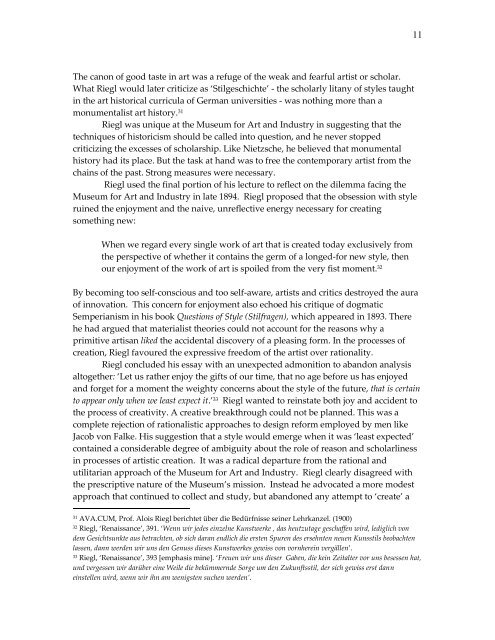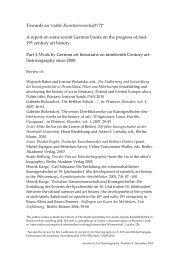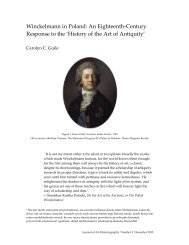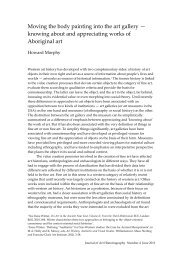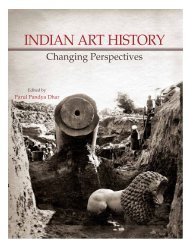The advantages and disadvantages of Art History to Life: Alois Riegl ...
The advantages and disadvantages of Art History to Life: Alois Riegl ...
The advantages and disadvantages of Art History to Life: Alois Riegl ...
You also want an ePaper? Increase the reach of your titles
YUMPU automatically turns print PDFs into web optimized ePapers that Google loves.
<strong>The</strong> canon <strong>of</strong> good taste in art was a refuge <strong>of</strong> the weak <strong>and</strong> fearful artist or scholar.<br />
What <strong>Riegl</strong> would later criticize as ‘Stilgeschichte’ - the scholarly litany <strong>of</strong> styles taught<br />
in the art his<strong>to</strong>rical curricula <strong>of</strong> German universities - was nothing more than a<br />
monumentalist art his<strong>to</strong>ry. 31<br />
<strong>Riegl</strong> was unique at the Museum for <strong>Art</strong> <strong>and</strong> Industry in suggesting that the<br />
techniques <strong>of</strong> his<strong>to</strong>ricism should be called in<strong>to</strong> question, <strong>and</strong> he never s<strong>to</strong>pped<br />
criticizing the excesses <strong>of</strong> scholarship. Like Nietzsche, he believed that monumental<br />
his<strong>to</strong>ry had its place. But the task at h<strong>and</strong> was <strong>to</strong> free the contemporary artist from the<br />
chains <strong>of</strong> the past. Strong measures were necessary.<br />
<strong>Riegl</strong> used the final portion <strong>of</strong> his lecture <strong>to</strong> reflect on the dilemma facing the<br />
Museum for <strong>Art</strong> <strong>and</strong> Industry in late 1894. <strong>Riegl</strong> proposed that the obsession with style<br />
ruined the enjoyment <strong>and</strong> the naive, unreflective energy necessary for creating<br />
something new:<br />
When we regard every single work <strong>of</strong> art that is created <strong>to</strong>day exclusively from<br />
the perspective <strong>of</strong> whether it contains the germ <strong>of</strong> a longed-for new style, then<br />
our enjoyment <strong>of</strong> the work <strong>of</strong> art is spoiled from the very fist moment. 32<br />
By becoming <strong>to</strong>o self-conscious <strong>and</strong> <strong>to</strong>o self-aware, artists <strong>and</strong> critics destroyed the aura<br />
<strong>of</strong> innovation. This concern for enjoyment also echoed his critique <strong>of</strong> dogmatic<br />
Semperianism in his book Questions <strong>of</strong> Style (Stilfragen), which appeared in 1893. <strong>The</strong>re<br />
he had argued that materialist theories could not account for the reasons why a<br />
primitive artisan liked the accidental discovery <strong>of</strong> a pleasing form. In the processes <strong>of</strong><br />
creation, <strong>Riegl</strong> favoured the expressive freedom <strong>of</strong> the artist over rationality.<br />
<strong>Riegl</strong> concluded his essay with an unexpected admonition <strong>to</strong> ab<strong>and</strong>on analysis<br />
al<strong>to</strong>gether: ‘Let us rather enjoy the gifts <strong>of</strong> our time, that no age before us has enjoyed<br />
<strong>and</strong> forget for a moment the weighty concerns about the style <strong>of</strong> the future, that is certain<br />
<strong>to</strong> appear only when we least expect it.’ 33 <strong>Riegl</strong> wanted <strong>to</strong> reinstate both joy <strong>and</strong> accident <strong>to</strong><br />
the process <strong>of</strong> creativity. A creative breakthrough could not be planned. This was a<br />
complete rejection <strong>of</strong> rationalistic approaches <strong>to</strong> design reform employed by men like<br />
Jacob von Falke. His suggestion that a style would emerge when it was ‘least expected’<br />
contained a considerable degree <strong>of</strong> ambiguity about the role <strong>of</strong> reason <strong>and</strong> scholarliness<br />
in processes <strong>of</strong> artistic creation. It was a radical departure from the rational <strong>and</strong><br />
utilitarian approach <strong>of</strong> the Museum for <strong>Art</strong> <strong>and</strong> Industry. <strong>Riegl</strong> clearly disagreed with<br />
the prescriptive nature <strong>of</strong> the Museum’s mission. Instead he advocated a more modest<br />
approach that continued <strong>to</strong> collect <strong>and</strong> study, but ab<strong>and</strong>oned any attempt <strong>to</strong> ‘create’ a<br />
31 AVA.CUM, Pr<strong>of</strong>. <strong>Alois</strong> <strong>Riegl</strong> berichtet über die Bedürfnisse seiner Lehrkanzel. (1900)<br />
32 <strong>Riegl</strong>, ‘Renaissance’, 391. ‘Wenn wir jedes einzelne Kunstwerke , das heutzutage geschaffen wird, lediglich von<br />
dem Gesichtsunkte aus betrachten, ob sich daran endlich die ersten Spuren des ersehnten neuen Kunsstils beobachten<br />
lassen, dann werden wir uns den Genuss dieses Kunstwerkes gewiss von vornherein vergällen’.<br />
33 <strong>Riegl</strong>, ‘Renaissance’, 393 [emphasis mine]. ‘Freuen wir uns dieser Gaben, die kein Zeitalter vor uns besessen hat,<br />
und vergessen wir darüber eine Weile die bekümmernde Sorge um den Zukunftsstil, der sich gewiss erst dann<br />
einstellen wird, wenn wir ihn am wenigsten suchen werden’.<br />
11


